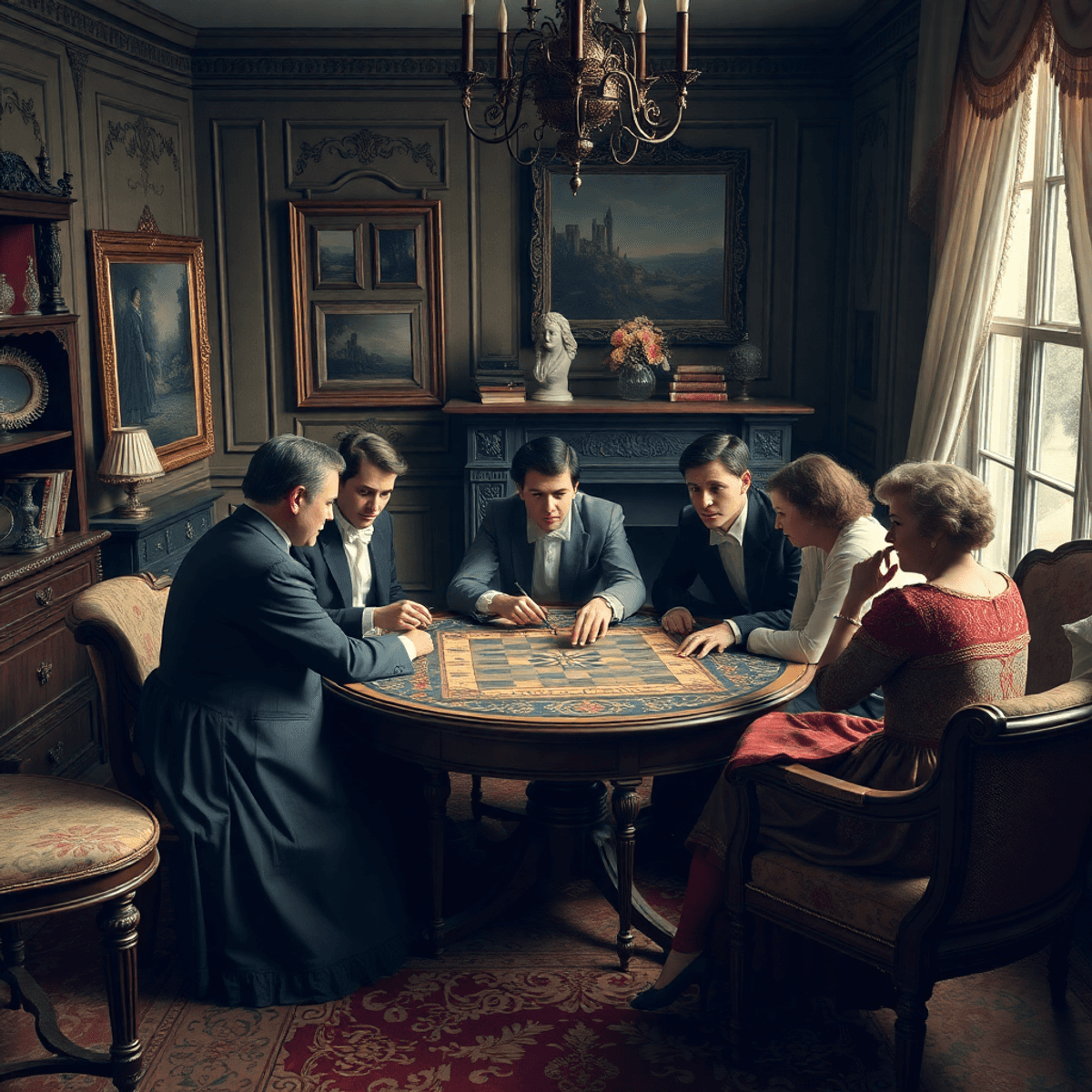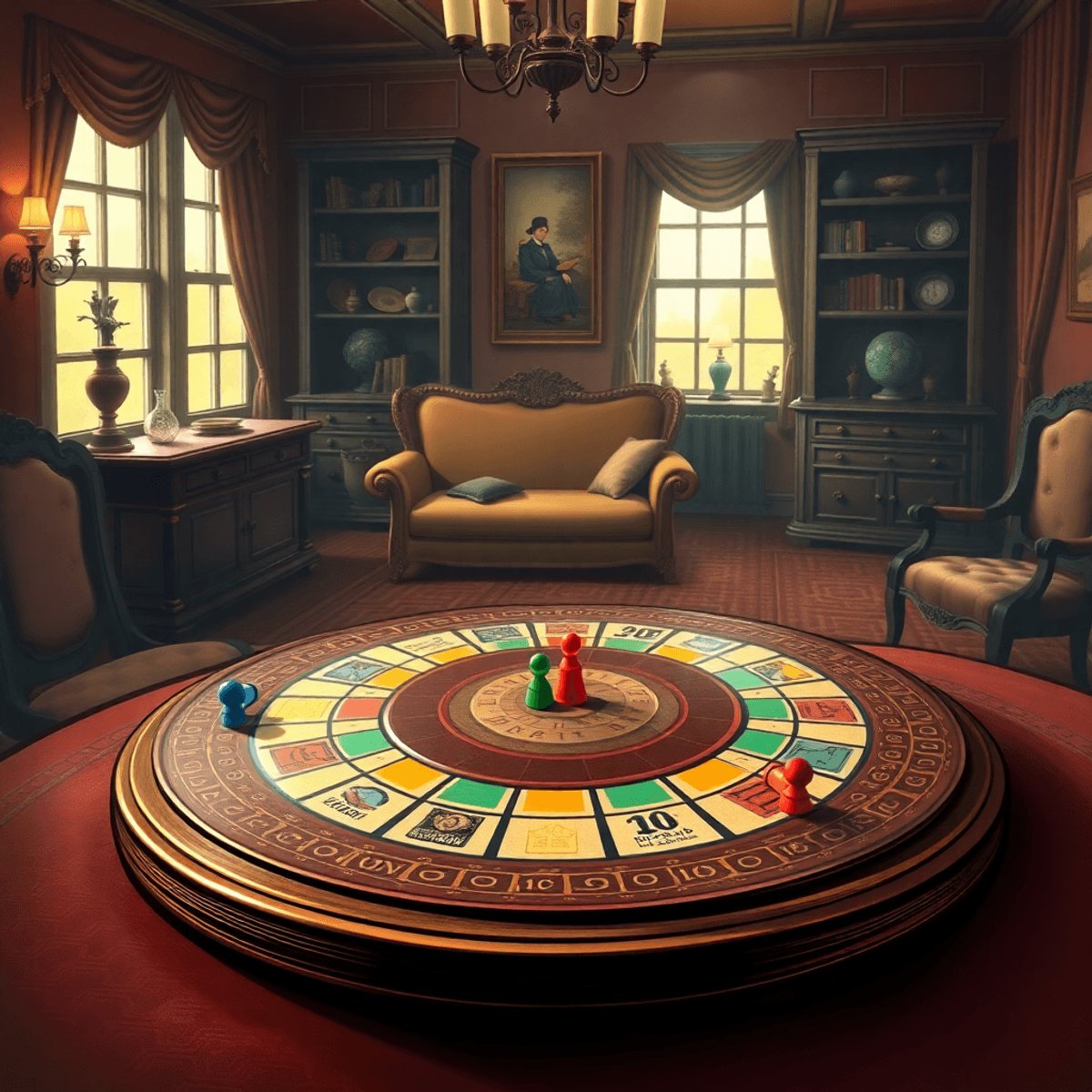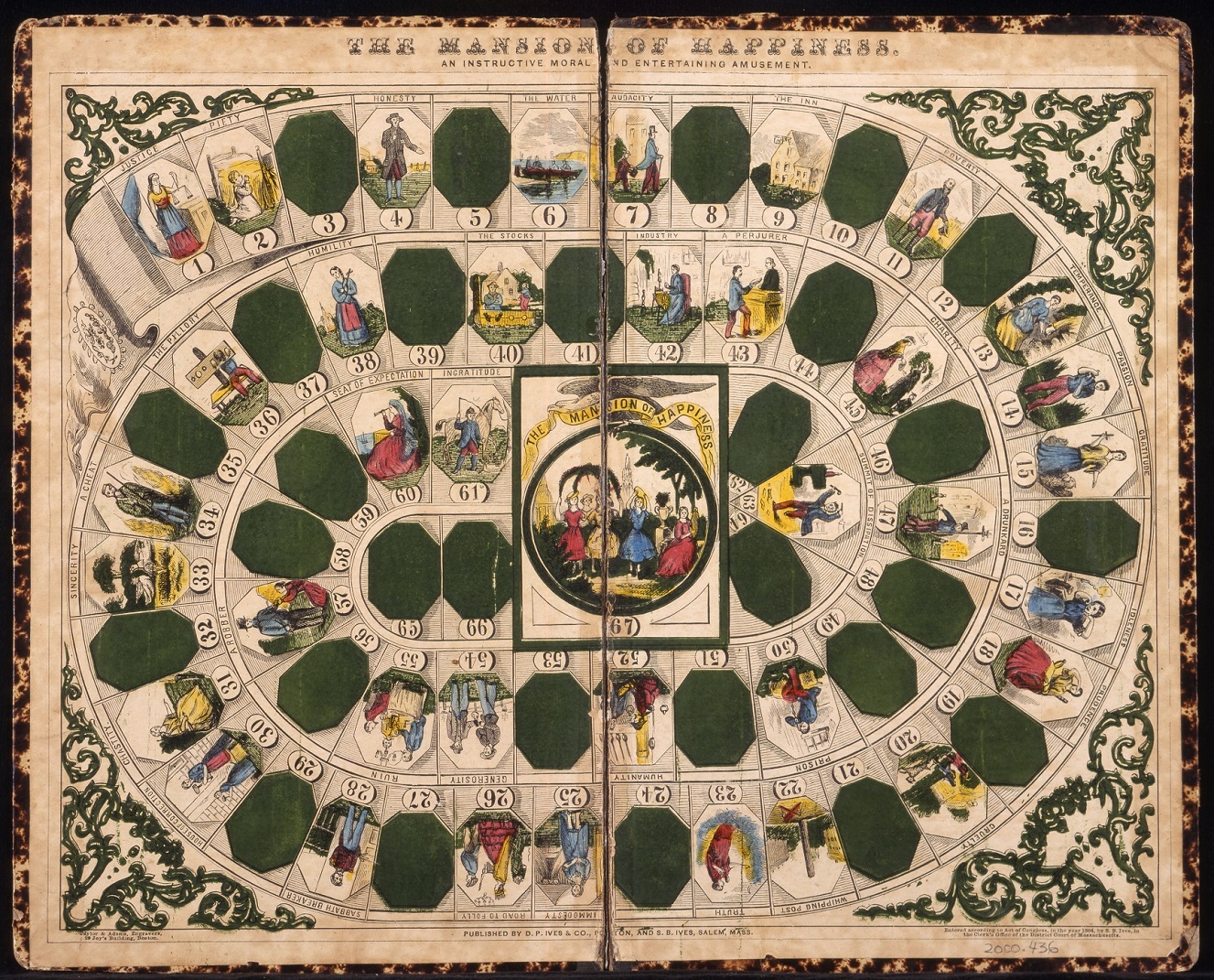
Victorian parlor games were a refined and elegant form of entertainment, and the Auctioneer board game stood out as one of the most fascinating titles of the 19th century. It offered more than amusement—it educated players about the world of art collecting and auction houses. In Auctioneer, social gatherings transformed into lively bidding competitions as players vied for illustrated treasures modeled after real Victorian artwork. More than just a game, it provided a glimpse into the sophisticated world of art acquisition and auction etiquette.
Through gameplay, participants honed their skills in bidding, bluffing, and competing for valuable pieces. These abilities remain relevant today, influencing modern auction-style games and shaping strategic approaches to resource management and market value assessment.
From Victorian Games to Modern Genres
As we delve deeper into gaming history, it becomes clear how historical titles like the Auctioneer board game laid the foundation for a variety of modern genres. From deck-building and card-driven mechanics to legacy campaign systems, many contemporary board games owe their strategic depth to early innovations introduced by games like Auctioneer.
Even ancient and medieval board games have left an indelible mark on our current understanding of tabletop entertainment. By examining these lost games that shaped history, we gain insight into their influence on present-day board game appreciation.
Join us as we delve into how this remarkable game not only impacted tabletop entertainment but also influenced different facets of modern gaming culture—particularly auction-based gameplay.
The Victorian Era and the Rise of Board Games
The Victorian era marked a golden age for board games, transforming them from simple pastimes into sophisticated entertainment centerpieces. Wealthy Victorian households dedicated entire evenings to gaming sessions, with parlor games becoming a cornerstone of social gatherings.
These games served multiple purposes in Victorian society:
- Social Education: Games taught proper etiquette and social graces to children and young adults
- Moral Instruction: Many games incorporated lessons about virtue, work ethic, and proper behavior
- Academic Learning: Historical facts, geography, and arithmetic were cleverly woven into gameplay
- Family Bonding: Gaming sessions brought together multiple generations in shared entertainment
Craftsmanship and Luxury in Game Production
Victorian game manufacturers spared no expense in production quality. Games featured:
- Hand-painted illustrations
- Intricate wooden boards
- Finely carved playing pieces
- Detailed instruction manuals with gold leaf embellishments
The Victoria and Albert Museum’s collection showcases this dedication to craftsmanship, housing numerous examples of ornate game boards featuring elaborate Victorian motifs and decorative elements. BoardGameGeek’s historical archives document how these games often cost several weeks’ wages, highlighting their status as luxury items.
The rise of the middle class and increased leisure time fueled demand for these games. Manufacturers like Jaques of London and Spear’s Games produced increasingly sophisticated titles, while advances in printing technology allowed for more detailed and colorful game components.
This period also saw the evolution of gaming elements, such as dice, which have a rich history in board games. These dice not only added randomness to gameplay but also influenced strategy significantly.
Moreover, the Victorian era was not just about Western-style board games. It was also a time when unique cultural regional games from around the world started gaining popularity. These traditional board games reveal the rich traditions behind them and their significance in different cultures.
The impact of forgotten predecessors on modern classics cannot be overlooked. These earlier games shaped many mechanics and themes that we see in today’s board games.
As we delve deeper into the world of board games, it’s important to explore the history of Eurogames which have become a global phenomenon. Their origins and cultural impact continue to influence modern gaming culture significantly.
Finally, understanding the timeless journey of classic board games through history can provide valuable insights into their enduring impact on society. From ancient origins to modern influence, classic board games have shaped our cultural landscape in profound ways.
Auctioneer: A Unique Victorian Board Game
Published in 1863 by London-based McLoughlin Brothers, Auctioneer captured the spirit of Victorian society’s growing obsession with art collecting and auction houses. The game’s creator, Thomas Worth, drew inspiration from the bustling auction scenes at Christie’s and Sotheby’s, where wealthy collectors gathered to bid on precious artifacts.
Authentic Representation of Period-Specific Items
The game’s distinctive appeal lay in its authentic representation of period-specific items. Players competed for:
- Fine Art Pieces: Miniature reproductions of famous paintings
- Antique Furniture: Detailed illustrations of Victorian furnishings
- Rare Books: Cards featuring first editions and manuscripts
- Decorative Objects: Porcelain, silver, and other collectibles
Historical Significance of Auctioneer
The Victoria and Albert Museum houses several original Auctioneer sets in its collection, showcasing the game’s historical significance. These preserved specimens reveal intricate hand-colored lithographs and carefully crafted playing pieces that mirror actual auction catalogs from the era.
The British Museum’s archives document how Auctioneer reflected the period’s rising middle class, who sought to emulate aristocratic collecting habits. The game served as both entertainment and social education, teaching players the nuances of value assessment and bidding strategies common in Victorian auction houses.
Influence on Future Games
BoardGameGeek’s historical database highlights Auctioneer as one of the first games to introduce competitive bidding mechanics, setting a precedent for future auction-based games. This innovative approach can be seen as a precursor to modern gaming trends that involve tile placement and modular game design, which have evolved significantly since the Victorian era. Such board games reflect a cultural evolution that has shaped the landscape of social leisure activities over time.
Understanding Auctioneer’s Gameplay Mechanics
At its core, Auctioneer captures the thrilling atmosphere of a Victorian auction house with simple yet elegant gameplay mechanics. Players take turns acting as both bidders and auctioneers, managing a hand of illustrated cards showcasing valuable artworks, antiques, and collectibles.
How the Game Works
- Auctioneer’s Role: Each round starts with the chosen auctioneer picking an item from their collection to auction off.
- Setting the Stage: The auctioneer decides on the initial price, creating immediate tension as players assess the item’s potential value against their available funds.
- Bidding Wars: Players engage in bidding wars, trying to outsmart each other and secure the item for themselves.
- Strategic Decisions: Throughout the game, players must make strategic decisions about when to bid aggressively and when to conserve their resources for future opportunities.
Strategies for Success
To excel in Auctioneer, players need to employ various strategies:
- Timing bids to maximize value while preserving capital
- Reading opponents’ reactions to gauge their interest
- Bluffing to drive up prices on less valuable items
- Building collections of complementary pieces for bonus points
Learning through Gameplay
One of the unique aspects of Auctioneer is its educational value. The game authentically represents auction house protocols and teaches players important skills such as:
- Proper bidding etiquette
- Price evaluation techniques
- Collection management skills
- Understanding market dynamics
By playing Auctioneer, individuals can enhance their understanding of auction strategy and gain insights into the social dynamics of Victorian high society.
The Artistic Design Behind Auctioneer
The artistic elements of Auctioneer showcase the pinnacle of Victorian craftsmanship. Each game card features intricate hand-drawn illustrations of period-appropriate artworks and antiques, rendered with meticulous attention to detail. The artists employed chromolithography techniques – a revolutionary printing method for the era – to achieve rich, vibrant colors that brought each item to life.
The game board itself serves as a testament to Victorian design sensibilities, adorned with ornate borders and decorative elements typical of the period’s aesthetic preferences. Elaborate scrollwork frames the playing spaces, while carefully chosen typefaces reflect the elegant typography of 19th-century commercial art.
Production quality matched the artistic ambition. Manufacturers used sturdy cardboard stock treated with special coatings to prevent wear, while the playing pieces were crafted from polished wood or carved bone. According to The Victorian Board Game Collector’s Guide, these premium materials positioned Auctioneer as a luxury item meant for display as much as play.
The game’s visual presentation aligned with broader trends in Victorian game manufacturing. As noted in Games and Gaming: An Introduction to New Media, publishers like Jaques of London set high standards for board game artwork during this period, treating each release as an opportunity to demonstrate technical and artistic excellence. Auctioneer’s refined aesthetic helped establish these games as respectable additions to any proper Victorian home.
The Legacy of Auctioneer Among Early Economic Board Games
Auctioneer carved a distinctive path in the evolution of economic board games during the Victorian era. Its innovative bidding mechanics laid the groundwork for future games centered around market dynamics and resource management.
The game’s influence resonates through several notable titles from the late 19th century:
- The Game of Commerce (1861) – Built upon Auctioneer’s foundation by introducing stock market elements
- The Merchant of Venice (1883) – Incorporated similar bidding mechanics for trading goods
- Business (1904) – Adapted auction principles for property acquisition
These early economic games shared Auctioneer’s core focus on financial strategy and market manipulation. The game’s success inspired designers to explore deeper economic concepts through tabletop experiences.
Standing Out Among Victorian Games
Historical game collections reveal Auctioneer’s unique position among its contemporaries. While other games of the era focused on moral lessons or geographical knowledge, Auctioneer stood out by simulating real-world economic activities. This practical approach to gaming earned praise from educators and economists alike.
The game’s mechanics proved particularly influential in the development of:
- Resource valuation systems
- Competitive bidding structures
- Market price fluctuations
- Player-driven economies
Documented evidence from period publications shows Auctioneer’s mechanics being studied and adapted by subsequent game designers, cementing its place as a pioneering title in economic gaming history.
However, as time progressed, many such games faded into obscurity, becoming part of lost and obscure board games history. The unique blend of strategy and market dynamics that Auctioneer introduced paved the way for a variety of genres in board gaming, including worker placement and social party games, each with their own evolution and impact on society. Additionally, the principles established by Auctioneer also found their way into strategy board games, demonstrating the far-reaching influence of this pioneering title.
Interestingly, the principles learned from Auctioneer extend beyond board games into real-world applications such as commercial real estate lending, where understanding market dynamics and resource management is crucial. Moreover, these principles are also relevant in sectors experiencing significant changes, like in the electricity sector where the PUC is actively adapting, showcasing the broader impact of such economic strategies.
How Auctioneer Influenced Modern Bidding Games
The influence of Auctioneer can be seen in many popular auction-based board games today. Modern classics like Modern Art by Reiner Knizia inherited the core principle of value speculation and competitive bidding from its Victorian ancestor. Players in both games must carefully assess artwork values while reading their opponents’ intentions.
Pioneering Multi-Phase Auctions
The multi-phase auction system introduced by Auctioneer found new life in Power Grid, where players bid on power plants using different auction formats. Game designer Friedemann Friese acknowledged drawing inspiration from historical auction games, noting how Victorian-era mechanics created natural player interaction and market dynamics.
Key Design Elements Passed Down
Notable design elements that carried forward include:
- The tension of hidden information during bidding
- Strategic fund management across multiple rounds
- Social deduction through opponent behavior, which can sometimes lead to manipulative behavior as part of the strategy
- Variable item values based on market conditions
Leading game historian David Parlett points to Auctioneer as “the first board game to successfully gamify auction psychology.” This assessment rings true in contemporary titles like High Society and Ra, where players must balance risk-taking with resource conservation.
Expanding Influence: Digital Platforms and Collecting Games
The game’s influence extends to digital platforms, with video game designers adapting its core mechanics for online marketplaces and auction house simulations. Popular collecting games like Magic: The Gathering incorporate similar principles in their trading systems, which can sometimes lead to situations where selling Magic cards might land you in jail.
Conclusion
The allure of auction mechanics continues to thrive across generations. From the Auctioneer board game’s elegant Victorian parlor rooms to today’s dynamic tabletop scenes, the thrill of strategic bidding remains one of the most engaging and competitive aspects of board gaming.
Modern gamers can discover rich insights by exploring these historical roots. The carefully crafted mechanics and social dynamics of Auctioneer reveal timeless principles that still shape contemporary game design. Each bid, bluff, and calculated risk in today’s auction games carries echoes of those Victorian evenings.
Ready to dive deeper? Consider these pathways:
- Track down vintage auction games at specialty shops and museums
- Try modern classics like Modern Art or Power Grid
- Host a themed game night comparing historical and contemporary bidding mechanics
- Join online communities discussing the evolution of auction gameplay
The lasting influence of the Auctioneer board game proves that truly great mechanics transcend their time. Its core gameplay elements still echo in modern auction-based games, connecting past and present through the timeless excitement of strategic play and competitive bidding.




